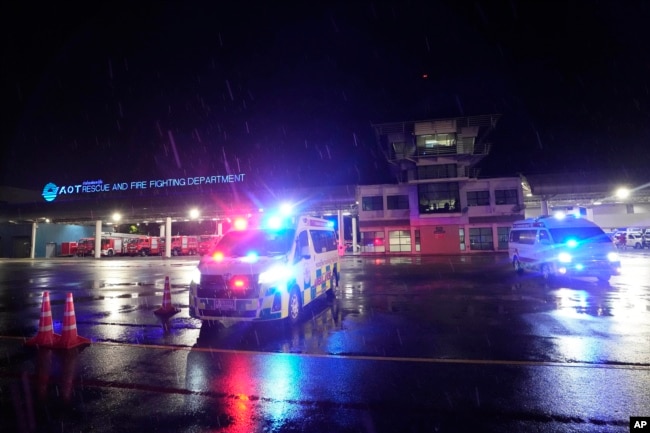AUDIO
When Does Air Turbulence Become Dangerous?

If you have flown on an airplane before, you might have experienced turbulence. Turbulence is a sudden movement of air. It can move the plane around and force sudden changes in height.
Flying through mild turbulence feels like driving a car over big bumps or holes in the road.
But passengers on a Singapore Airlines flight on Tuesday experienced severe turbulence. Several people were injured and one person, a 73-year-old British man, died. The exact cause of the man’s death is still unclear.
While turbulence-related deaths are rare, injuries have increased over the years. Some weather and aviation experts have noted increasing reports of turbulence. They say climate change may be behind the increase.
What is turbulence?
Turbulence is unstable air that moves unpredictably. Most people link it with heavy storms. But the most dangerous kind is clear-air turbulence. This often happens with no warning signs in the sky ahead.
Clear-air turbulence happens most often in or near rivers of air called jet streams. The cause is something called wind shear. That is when two huge air masses near each other move at different speeds. If the difference in speed is big enough, it breaks into circular movements.
Thomas Guinn is an aviation science expert at the Embry-Riddle Aeronautical University in Daytona Beach, Florida. He said, “When you get strong wind shear near the jet stream, it can cause the air to overflow. And that creates these chaotic motions in the air.”

How common are turbulent-related injuries?
The U.S. National Transportation Safety Board (NTSB) reported that more than one-third of all airline incidents in the U.S. from 2009 to 2018 were related to turbulence. Most of them resulted in one or more serious injuries to passengers, but no damage to the plane.
Between 2009 and 2022, the NTSB said 163 people were injured seriously enough during turbulence events to require hospital treatment for at least two days. Most of those injured were flight attendants. They are especially at risk because they are more likely to be out of their seats during a flight.
Singapore Airlines said its plane dropped about 1,800 meters in about three minutes last Tuesday, after hitting severe turbulence over the Indian Ocean. In addition to the one death, six or seven passengers were severely injured. Several others suffered less serious injuries.
Larry Cornman is a scientist at the U.S. National Center for Atmospheric Research. He has studied turbulence for many years. He said, “It’s not uncommon to have turbulence encounters that cause minor injuries up to, say, a broken bone,… But fatalities are very, very rare — especially for large transport aircraft.”
Stuart Fox is with the International Air Transport Association. He said, until Tuesday, it had been 27 years since a passenger died following clear-air turbulence on a major airline.
Can pilots avoid turbulence?
Pilots use several methods to avoid turbulence, including using weather radar images. Sometimes they can simply see and fly around the storms.
But clear-air turbulence can happen unexpectedly.
Doug Moss is a former airline pilot and safety expert. He said air traffic controllers will warn pilots after another plane runs into clear-air turbulence. Many pilots also look at the upper-level jet streams along their flight path for signs of wind shear. They can plan to move above, below, or around those areas, he added.

Does climate change lead to more turbulence?
Some scientists note that reports of turbulence encounters are on the rise. There are several possible explanations for that. But several researchers have pointed to climate change.
Guinn, of Embry-Riddle Aeronautical University, explained that some experts predict climate change could change the jet stream and increase the wind shear. This would drive up turbulence in the air.
Paul Williams is a professor of atmospheric science at Britain’s University of Reading. In a statement Tuesday, he said there was “strong evidence that turbulence is increasing because of climate change.”
Williams said his research team recently discovered that severe clear-air turbulence in the North Atlantic has increased by 55 percent since 1979. The team estimated that severe turbulence in the jet streams could double or triple in the coming years under current conditions.
Other experts note that an increase in air travel could be the reason for the increase in turbulence encounters.
How can travelers stay safe?
Turbulence can be hard to predict. But experts note that the first line of defense in the air is keeping seat belts fastened whenever possible.
“Wear your seat belt,” Guinn said. “That’s just a really quick fix to prevent injury.”
______________________________________________
Words in This Story
aviation - n. the business and practice of flying airplanes, helicopters...
unstable - adj. having a physical state that can change easily
chaotic - adj. in a state of complete confusion or disorder
encounter - n. an occasion when you deal with or experience something
fatality - n. a death that results from a disaster, accident
triple - v. to cause something to become three times as many
fasten - v. to close and attch something
https://learningenglish.voanews.com/a/when-does-air-turbulence-become-dangerous-/7622484.html